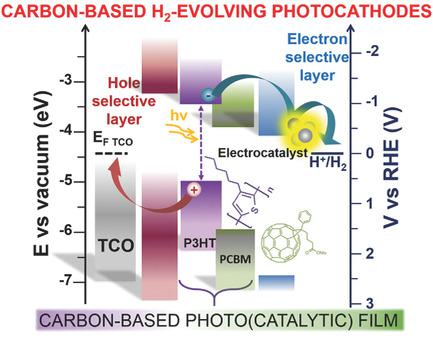当前位置:
X-MOL 学术
›
Adv. Mater.
›
论文详情
Our official English website, www.x-mol.net, welcomes your
feedback! (Note: you will need to create a separate account there.)
Carbon‐Based Photocathode Materials for Solar Hydrogen Production
Advanced Materials ( IF 27.4 ) Pub Date : 2018-09-16 , DOI: 10.1002/adma.201801446 Sebastiano Bellani 1 , Maria Rosa Antognazza 2 , Francesco Bonaccorso 1, 3
Advanced Materials ( IF 27.4 ) Pub Date : 2018-09-16 , DOI: 10.1002/adma.201801446 Sebastiano Bellani 1 , Maria Rosa Antognazza 2 , Francesco Bonaccorso 1, 3
Affiliation

|
Hydrogen is considered a promising environmentally friendly energy carrier for replacing traditional fossil fuels. In this context, photoelectrochemical cells effectively convert solar energy directly to H2 fuel by water photoelectrolysis, thereby monolitically combining the functions of both light harvesting and electrolysis. In such devices, photocathodes and photoanodes carry out the hydrogen evolution reaction (HER) and the oxygen evolution reaction (OER), respectively. Here, the focus is on photocathodes for HER, traditionally based on metal oxides, III–V group and II–VI group semiconductors, silicon, and copper‐based chalcogenides as photoactive material. Recently, carbon‐based materials have emerged as reliable alternatives to the aforementioned materials. A perspective on carbon‐based photocathodes is provided here, critically analyzing recent research progress and outlining the major guidelines for the development of efficient and stable photocathode architectures. In particular, the functional role of charge‐selective and protective layers, which enhance both the efficiency and the durability of the photocathodes, is discussed. An in‐depth evaluation of the state‐of‐the‐art fabrication of photocathodes through scalable, high‐troughput, cost‐effective methods is presented. The major aspects on the development of light‐trapping nanostructured architectures are also addressed. Finally, the key challenges on future research directions in terms of potential performance and manufacturability of photocathodes are analyzed.
中文翻译:

用于太阳能制氢的碳基光电阴极材料
氢被认为是替代传统化石燃料的一种有前途的环保能源载体。在这种情况下,光电化学电池可有效地将太阳能直接转化为H 2。通过水的光电解燃料,从而单方面结合了光收集和电解的功能。在这样的设备中,光阴极和光阳极分别进行氢释放反应(HER)和氧释放反应(OER)。在这里,重点是用于HER的光电阴极,传统上基于金属氧化物,III-V族和II-VI族半导体,硅和铜基硫族化物作为光敏材料。最近,碳基材料已经成为上述材料的可靠替代品。本文提供了基于碳的光电阴极的观点,对近期的研究进展进行了批判性分析,并概述了开发高效,稳定的光电阴极体系结构的主要指导原则。特别是电荷选择层和保护层的功能性作用,讨论了提高光电阴极的效率和耐用性的方法。本文介绍了通过可扩展,高通量,经济高效的方法对光电阴极的最新制造方法的评估。还讨论了捕光纳米结构开发的主要方面。最后,分析了光电阴极的潜在性能和可制造性对未来研究方向的关键挑战。
更新日期:2018-09-16
中文翻译:

用于太阳能制氢的碳基光电阴极材料
氢被认为是替代传统化石燃料的一种有前途的环保能源载体。在这种情况下,光电化学电池可有效地将太阳能直接转化为H 2。通过水的光电解燃料,从而单方面结合了光收集和电解的功能。在这样的设备中,光阴极和光阳极分别进行氢释放反应(HER)和氧释放反应(OER)。在这里,重点是用于HER的光电阴极,传统上基于金属氧化物,III-V族和II-VI族半导体,硅和铜基硫族化物作为光敏材料。最近,碳基材料已经成为上述材料的可靠替代品。本文提供了基于碳的光电阴极的观点,对近期的研究进展进行了批判性分析,并概述了开发高效,稳定的光电阴极体系结构的主要指导原则。特别是电荷选择层和保护层的功能性作用,讨论了提高光电阴极的效率和耐用性的方法。本文介绍了通过可扩展,高通量,经济高效的方法对光电阴极的最新制造方法的评估。还讨论了捕光纳米结构开发的主要方面。最后,分析了光电阴极的潜在性能和可制造性对未来研究方向的关键挑战。











































 京公网安备 11010802027423号
京公网安备 11010802027423号